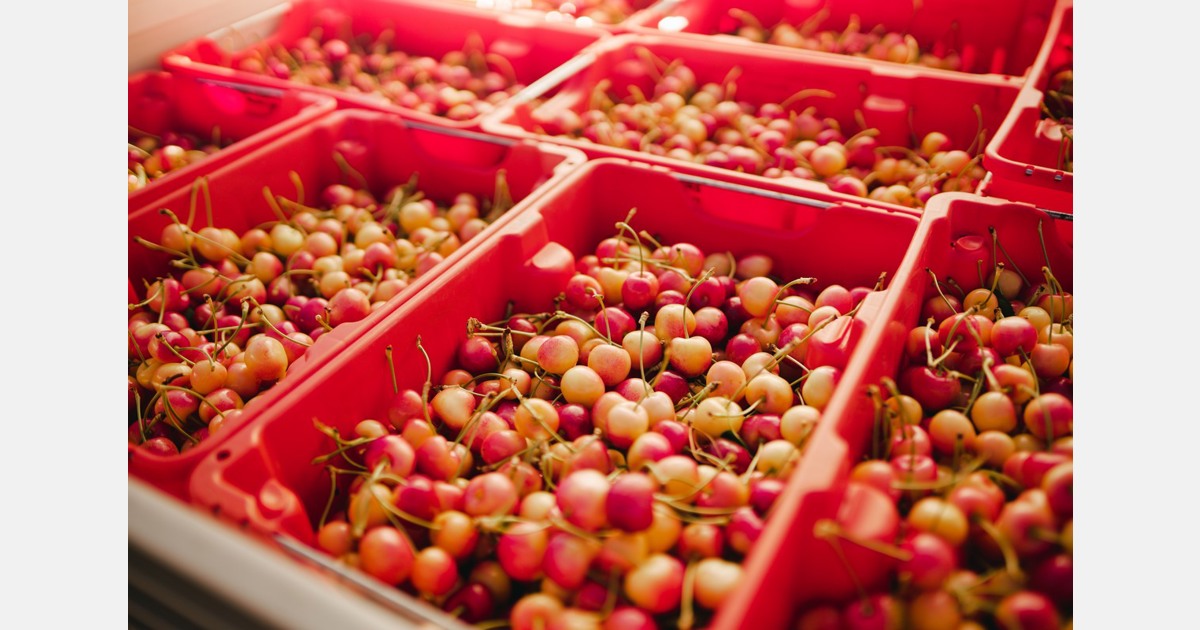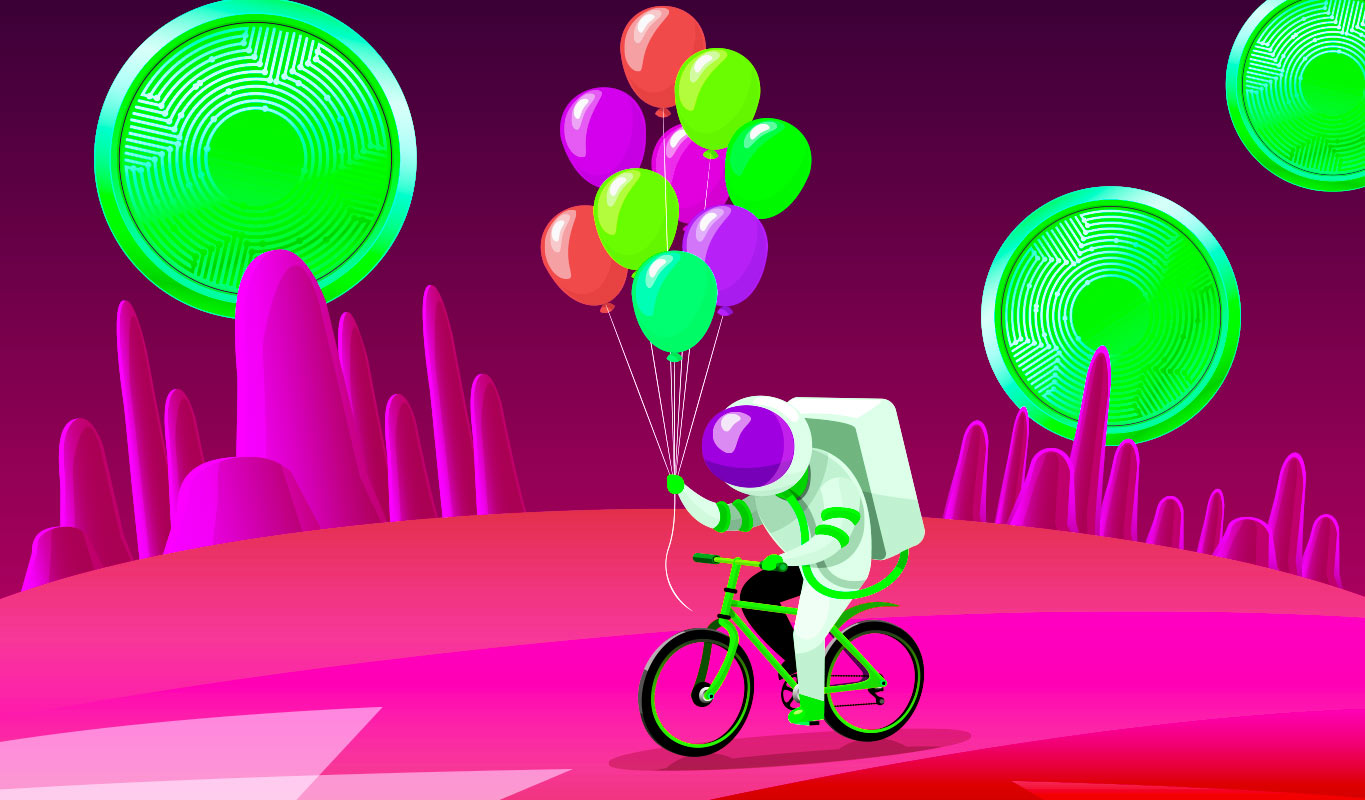Lifestyle
Yes, Apple's new iPad ad is ugly and crushing, but art can't be flattened


There is something so ugly about crushing an acoustic guitar. Making it buckle, making the middle of it explode in splinters. That might be personal to me, as someone who grew up with a dad who was what you might call a campfire guitarist — not a performer, just a dad who used to entertain us with songs like “Dark as a Dungeon,” a little folk tune about the lethal dangers of coal mining. Maybe to you, it’s not the guitar. Maybe it’s the cameras or the vinyl records.
A little more than halfway through the new ad for “the thinnest Apple product ever,” an enormous hydraulic press bears down on an acoustic guitar — and cameras, and records, and other things that hold reservoirs of emotion for people who make art. Paint, pencils, a dressmaker’s mannequin, books, a wooden model of a person, a not-yet-dry clay bust, a video game cabinet. Everything is flattened under its power. But the most spectacular crushings are of musical instruments — that guitar, a piano, a drum set, a trumpet standing on its end until it gives way.
YouTube
The ad — which Apple has since apologized for — is meant to communicate, I suppose, that this tiny, thin iPad can contain what is important from all these things. It can replace them all. You can make your music with it. You can paint with it. You can play games on it. You can take your photos with it. And it suggests this means you can finally destroy all those things that have been so burdensome, like massive pianos and messy paint.
But these are not practical items to begin with. Nobody owns a piano because it’s practical; it’s about the least practical thing you can own. It can wreck your floor. It goes out of tune. And if you happen to get a new place, you don’t just need movers for it; you may need special movers. You don’t own a piano to get from point A to point B in the most direct way you can. You own a piano for the reason we had one in my house: a person plays it. Someone sits down, as my mother did, and plays the “Maple Leaf Rag,” and you can hear the pedals lightly squeak, and you can watch hands skitter across keys, and of course you are listening to music — but also, those are your mother’s hands.
Of course, to be fair, the ad is also meant to cause controversy, because you do not crush beautiful things and offend accidentally. The ad says almost nothing about the iPad itself except that it’s very thin; the point is all the crushing, the point is the ugliness, so admittedly, to recognize that ugliness is to serve the ad’s purpose.
But its ugliness is also what proves the folly of its concept. The reason people will react as emotionally as they do to the vulgarity of the ad is precisely why the thinnest iPad yet cannot do what they say it will do. It cannot replace the things that people have, over hundreds of years, learned to carry and live beside, and to incorporate into their creation of what they hope will be beauty. Art is intertwined with humanity, with all its flawed dimensions, and the two cannot be separated. In the making of art, there is family, there are friends and collaborators, there is both fragility and permanence, and there is the passage of time. And there is physicality.

In our current environment, the ad plays as an extension of, or maybe a companion to, the idea that artificial intelligence — or what travels under that name — can take over the production of art: of books, of illustrations, of music, of films. We are enduring an all-out assault on the need for anyone’s idiosyncratic individuality to be involved in the creation of art. It is an attempt to reduce creative acts to devices with the right capabilities, to the point where machines can make it all entirely without us. We will, in this vision, order a book or a film as we do a mass-produced piece of fast fashion, and as such, it will be cheap and disposable and reliant on the exploitation of labor.
But the very fact that Apple knew this ad would make people so angry is how you know this reductive approach to art is doomed to fail. The people who made this ad specifically chose to crush things that are valuable not only because of their capabilities, but because they are things that creative people imbue with meaning, that they save up for and hand down to their kids. Those things will not be replaced by iPads.
You can make beautiful music with an iPad; you can make beautiful digital art. But that art will be made alongside other music, other art, not stacked on top of the corpses of old violins. If you think of new frontiers in art as an opportunity to destroy sculptures or explode bottles of paint, you never understood art at all, and you never will.
In certain kinds of stories, “I am not worried” is the last thing you say before the monster devours you. But while I am worried about the economics of art and its creation, I am not worried at all that art made by humans will ever vanish or be replaced by the thinnest iPad ever. The gasp that went up from so many people when they saw that guitar explode, that sound came from the part of a human being that makes art. And that part instinctively understands that beauty isn’t fixated on tech-world dominance. It doesn’t demand to crush what is loved in order to chase the fantasy that you can fit everything that matters into the pocket of a briefcase.
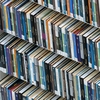


Lifestyle
Can you make music from Joshua trees — or is that wild science? Yes.

Artist Scott Kildall waves his microcontroller over a Joshua tree, recording wavelengths of light that are not perceptible by humans.
Carlos Jaramillo for NPR
hide caption
toggle caption
Carlos Jaramillo for NPR
The artist Scott Kildall is waving his hand over the contours of a Joshua tree, just inches from its spiky green, bayonet-like leaves.
“If I get too close to it, it will prick me and draw blood,” he says. “And it’s done that before.”
In his palm, he has a microcontroller — just about the size of a credit card. It’s got a few wires sticking out, and an infrared sensor, which picks up wavelengths of light just beyond what the human eye can perceive.
“It’s kind of like magic,” Kildall says. “And the magic is just revealing something that’s right beyond our levels of perception.”
The magic is part of Kildall’s latest sound installation — a work he calls Infrared Reflections. He developed the piece as an artist-in-residence at Joshua Tree National Park this spring, and it transforms near-infrared light bouncing off the iconic scraggly yuccas into a shimmering mosaic of otherworldly music — essentially turning the Joshua tree into an instrument.
Kildall is neither a computer scientist nor a musician, though he does play the ukulele. This artwork relies on both disciplines, as Kildall needs to build sensors, route their data to a computer, process and smooth that data, and convert it all into something beautiful for the ear.
“With art and technology, you have to constantly think about wearing multiple hats. Are you an IT person? Are you an artist? And you have to be able to troubleshoot on the fly,” he says.
The installation relies on a fundamental interplay between the sun and the Joshua tree. When sunlight hits the plant, cells in its healthy leaves soak up lots of red and blue light, and reflect back most of the green – which is why the clusters of piercing leaves at the end of the Joshua tree’s branches appear green to the human eye. (It’s also why most plants on Earth appear green to us.)

Spiky Joshua trees grow in Arthur B. Ripley Desert Woodland State Park, north of Los Angeles.
Carlos Jaramillo for NPR
hide caption
toggle caption
Carlos Jaramillo for NPR
But other types of light rain down on the Joshua tree too, including wavelengths we can’t see, like near-infrared light. The plant’s shaggy, grayish-brown bark doesn’t reflect much of that infrared light, but its healthy leaves — packed with compounds like water, carbohydrates and defense chemicals — reflect much more. And that’s exactly what Kildall sees as he passes his sensor from the yucca’s dead bark to its green, leafy buds.
“Beyond our perceptions lies a whole realm of invisible data,” he explains. “And so what I do is I find some sort of invisible phenomena such as water quality or air quality or infrared light reflection, and then map that data into sounds, so that we can hear that data.”
That technique is known as sonification, and Kildall has previously designed installations that sonify water flow in trees, or tap into the electrical signals of mushrooms. Infrared Reflections follows in that vein, but it’s much more site-specific — it’s meant to be played on the Joshua tree, which is endemic to the Mojave Desert.

Kildall needs a speaker and a bag of equipment on site to make his music.
Carlos Jaramillo for NPR
hide caption
toggle caption
Carlos Jaramillo for NPR
With that in mind, earlier today Kildall lugged his laptop, a box of electronics and a giant speaker into a field full of Joshua trees at the Arthur B. Ripley Desert Woodland State Park, north of Los Angeles.
Gusts of wind scream through the high desert here, and Kildall eyes individual Joshua trees with the eagerness of a kid at Guitar Center, ready to pick out an axe.
“I see one Joshua tree that’s about a hundred feet away that is moving a little bit in the wind and has multiple leafy sections and bark sections,” he says. “And that one really looks like it is asking to be sonified.”

Kildall’s speaker sits next to several Joshua trees.
Carlos Jaramillo for NPR
hide caption
toggle caption
Carlos Jaramillo for NPR
After a short walk, Kildall sets down the speaker and begins fiddling with his laptop. It’s perched on a camp chair, in direct sun, and refuses to boot up — a reminder, Kildall says, of how preparing for a field installation is like planning a NASA space mission (though with non-lethal stakes.)
“You want to reduce the number of points of failure. And so with the system I have, I have backup electronics, I only have one laptop. So that’s the only point of failure that I’m really worried about.”
But not to fear. The machine soon boots up, along with a local Wi-Fi network — which connects the small infrared sensor to the computer — and Kildall is ready to rock.

A view of Joshua trees at Arthur B. Ripley Desert Woodland State Park.
Carlos Jaramillo for NPR
hide caption
toggle caption
Carlos Jaramillo for NPR

Here’s the same landscape viewed through a thermal infrared camera. It captures a different part of the infrared spectrum from what Kildall is picking up with his sensor, but gives a sense of how these plants appear differently when viewed at different wavelengths of light.
Carlos Jaramillo for NPR
hide caption
toggle caption
Carlos Jaramillo for NPR
As he caresses the air just above the tree, the yowling of a theremin rises and falls from the speaker, lending an eerie soundtrack to the already alien-looking landscape. A few hikers walk by, but seem unphased by the guy performing reiki on a Joshua tree. The high desert is known for its eccentrics, after all.
Kildall has designed three more “instruments” to be played like this, along with the theremin sound.
His favorite combines the drone of a theremin with spiraling arpeggios.
Another sounds more like haunting electric guitars, reverberating in a cathedral.
The final sound is more pared-back and simple — resembling a kid plinking at the piano.
“In some ways, it feels a little bit more direct and accessible because we all kind of understand how to press notes randomly on the piano,” Kildall explains. “And as I move the sensor over these sort of leafy spots in the sun, those will produce a higher pitch on the piano.”
As he slides the sensor further down the branch, to the bark, the notes get lower and lower, moving deeper into the bass clef.
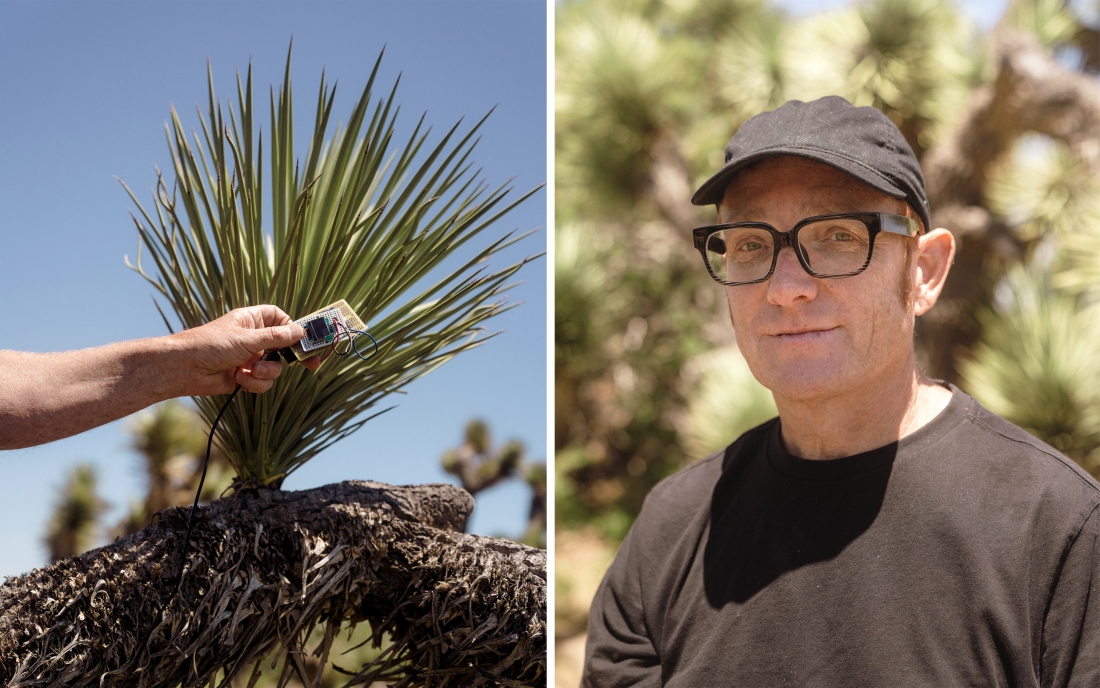
Kildall holds his device a few inches above a spiky Joshua tree to avoid getting pricked.
Carlos Jaramillo for NPR
hide caption
toggle caption
Carlos Jaramillo for NPR
It’s a fascinating way to make music. The infrared-sensing technology at the heart of the work also happens to be something scientists have employed for decades.
“From our aircraft or satellites, we use it to separate the living vegetation from the dead vegetation,” says Greg Asner of Arizona State University in Hawaii. “That’s very important in a grassland — is the grassland dry and ready to go up in smoke in a fire, or is it wet and green and living? And so we can translate that to fire fuel load for grasslands.”

Joshua trees viewed through a thermal infrared camera.
Carlos Jaramillo for NPR
hide caption
toggle caption
Carlos Jaramillo for NPR
Asner has also soared above the Amazon basin, measuring infrared signals from a plane — which allows him to tease out individual tree species, based on the fingerprints of infrared light that bounce off the trees.
“When I fly over a tropical rainforest with the infrared sensors, the maps literally are like Willy-Wonka-candy-store-style variation. They are amazing to look at,” he says.
“So there’s this enormous diversity of plants when you look at them in infrared light. And unfortunately, a lot of people just see them as green because that’s all we can see with our limited eyesight. There’s much more variety out there. And it’s a very beautiful world when you look at it in the infrared.”
Asner says he’s thrilled to see artists now experimenting with the same technology.

Left: A close up view of a Joshua tree. Right: A thermal infrared view of Kildall holding his device in front of a Joshua tree.
Carlos Jaramillo for NPR
hide caption
toggle caption
Carlos Jaramillo for NPR
“Our studies for decades now have been stuck in the halls of science. And this will help translate what we have come to understand, utilize, love as scientists — it’s going to translate it to a much wider audience.”
Kildall says, in some sense, that’s his goal.
“One of the things I like to do is to engage people with nature and issues of climate change and issues of ecology through means other than science articles,” he says. “Science articles are great. I read them all the time. However, they don’t engage people on a more visceral storytelling level, as artwork does.”
And though this installation was conceived and developed with the Joshua tree at its center, it could work with the infrared reflections of other plants, if Kildall calibrates his code — which is a good thing, since Kildall calls San Francisco home.
“There aren’t any Joshua trees in San Francisco, so I might have to go to Golden Gate Park and see what I come up with.”
Lifestyle
They cut their water bill by 90% and still have a 'showstopping' L.A. garden

Water-hungry lawns are symbols of Los Angeles’ past. In this series, we spotlight yards with alternative, low-water landscaping built for the future.
Looking out the front windows of their northeast L.A. home, Kyle Anido and Katie Cordeal say their front yard is barely recognizable from a year ago when it was a lawn.
“It’s crazy to see how lively the garden is now,” says Anido, a 37-year-old camera operator. “There is so much bee activity.”
A bee is drawn to the Bird’s-Eye Gilia in Katie Cordeal and Kyle Anido’s front yard.
“It has absolutely exploded,” adds Cordeal, 38. “It’s pretty incredible what has happened over the past 12 months. And we haven’t even watered the yard this year.”
The colorful ecosystem, which thrives without sprinklers, amendments, fertilizers, gardeners and gas-powered lawn equipment, is not lost on the couple’s 2½-year-old son, Owen.
“Bees!” he yelled with delight from the front porch, pointing to the pollinators feeding on the native California flowers in his front yard.
“Owen loves bugs,” Anido says of the boy’s vibrant playground.
When the couple purchased their first home in 2021, the front yard was an uninspired swath of Bermuda grass, an oddly placed palm that real estate agents hastily planted for staging purposes and white gravel.
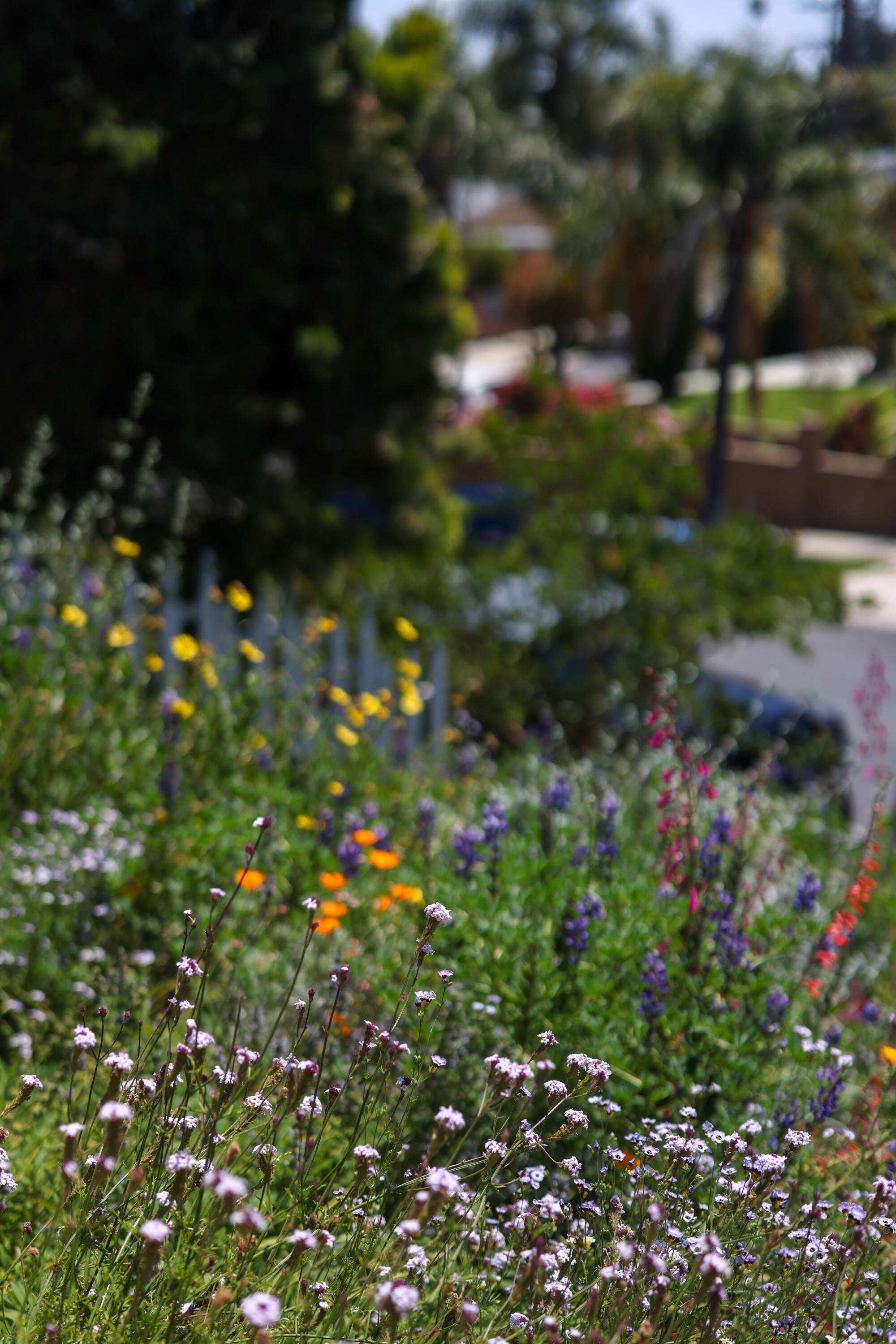
Homeowners Katie Cordeal and Kyle Anido wanted a colorful, drought-tolerant landscape.
(Dania Maxwell/Los Angeles Times)
After renting an apartment in Brooklyn, the couple felt intimidated by the prospect of caring for a home and yard and decided to keep the previous owners’ gardener. They did this, they say, because it was easy, but the noise and environmental pollution from the weekly “mow and blow” proved difficult for Cordeal, who works from home as a film and television production accountant.
“We would have to close all the doors and windows because the gas-powered leaf blower was so loud,” she says. “I hated the gas smell.”
Interested in conservation and drought-tolerant plants, the couple contacted garden designer Sophie Pennes of Urban Farms L.A. after viewing her before-and-after turf transformations — and lawn rants — on TikTok.
“I identified with what seems to be Sophie’s primary drivers — to support biodiversity, revitalize natural ecosystems, and conserve water,” Cordeal says. “Also, I could tell she is educated and passionate about what she does, and I enjoyed her dry humor.”
While this year’s record-setting rainfall may feel like an excuse to reconsider the argument for removing thirsty turf, that’s ludicrous, says Pennes, who specializes in edible gardens and California native gardens.
“Tearing out your lawn is about so much more than saving water,” the landscape designer says. “You don’t need to be a scientist to see the negative impact of lawns on the native habitat in any given city or ecology. It’s obvious when you’re walking through a neighborhood, and you stand in front of a grass lawn, and then you stand in front of a native garden: you can see the wildlife. We need to engage in the places where we live.”
Before and after photos courtesy of Katie Cordeal.
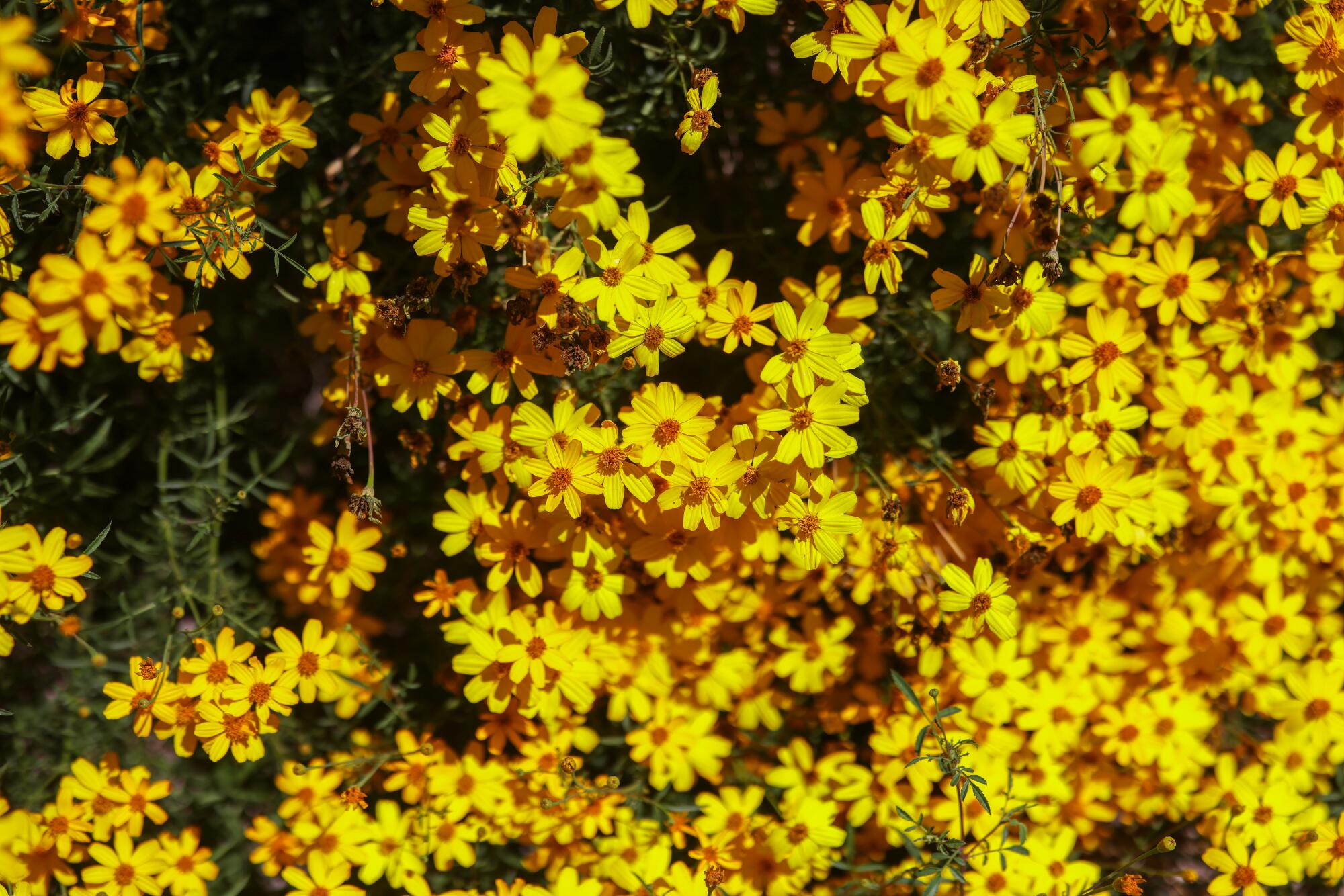
Mexican marigolds repel pests and attract birds.
After agreeing on a plant palette that included lots of color, wistfulness, texture and tall grasses, the couple hired a landscape contractor to remove their lawn by hand. They then sheet mulched the front yard — smothering it in wet cardboard — and waited for three months.
When it was time to plant, Pennes installed repeat groupings of three, including ceanothus, Canyon Prince Wild Rye and penstemon. “I wanted to have a bold effect when things were in bloom,” she says of the homeowners’ request for a colorful landscape. “I didn’t want it to be casual; I wanted it to be showstopping.”
A year later, the front yard is what they had hoped for. From the street, the 1937 residence appears modest, a two-bedroom house with two large picture windows. But the garden is indeed a showstopper. “It is such a magical walk to the front door,” Cordeal says of the lupine, poppies, penstemon and sage blooming on either side of the stairs up to the house.
Pennes designed the garden so that something is always in bloom regardless of the season. The purple Showy Penstemon is starting to fade, for instance, but the clarkia flowers are ready to open. On the parking strip, Hollyleaf Cherry and hardy Canyon Prince Wild Rye counter the pink clarkias and California bluebells. “Canyon Prince Wild rye has such a beautiful gray-green color that pops against the backdrop of the gray house,” Pennes notes.
Non-native plants include African Basil, “which the bees love,” Cordeal says, as well as Meyer lemon and Hass avocado trees, which the couple feed with water from their bathtub through a graywater system installed by Greywater Corp. Pennes also planted Mexican marigold to help repel pests and attract wildlife. “The finches love it,” Pennes says. “As soon as you put the plants in, the butterflies and birds find them. It really is an ‘if you build it, they will come,’” she laughs.
The couple estimates they paid around $14,900 for the transformation, including the design, labor, plants, trees and mulch. After removing 1,150-square-feet of lawn in the front yard and the parking strip, their $5,750 turf replacement rebate from the Department of Water and Power brought the total down to $9,150. Over the past year, the couple also saw their water bill decrease by 90%. “Our June/July 2022 water bill was $210.99,” says Cordeal. Their bill for June/July 2023 water was $24.28, including the extra water used to establish the 1-gallon plants.
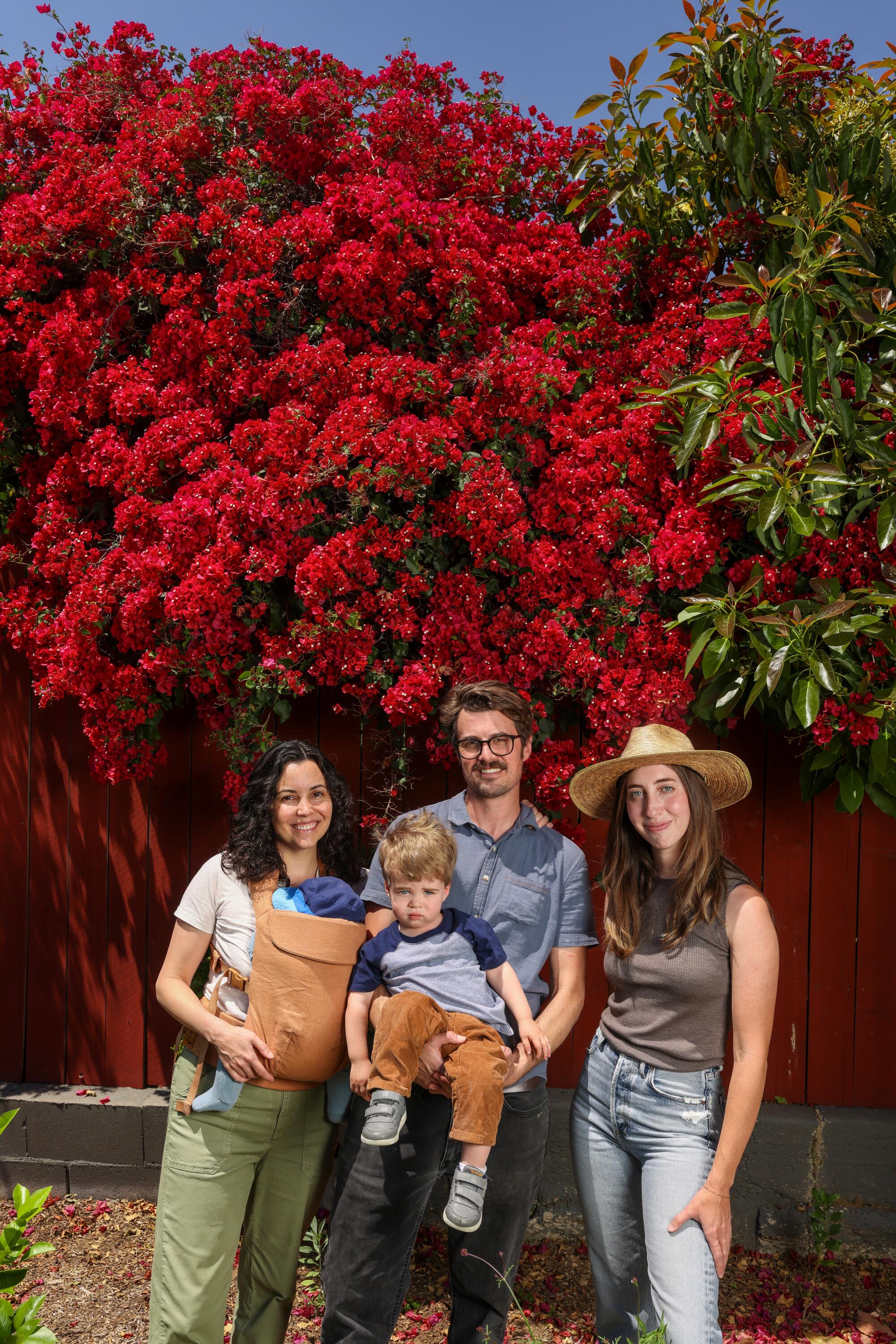
Homeowners Katie Cordeal and Kyle Anido with their newborn Felix, toddler Owen and Sophie Pennes of Urban Farms L.A., right, who helped landscape the yard.
But they are not stopping there. They are in preliminary talks with Pennes to overhaul their excessively hot backyard.
“We want to remove most of the concrete,” says Cordeal. “We want a veggie garden and another fruit tree that can use graywater. We want a lot more foliage in general to cool the backyard. We also need to figure out lots of play space for our two boys, but we’re not sure what ground cover that will be.”
You can be sure it won’t be artificial turf.
“My biggest enemy is plastic turf,” Pennes says. “Even if I get the opportunity to tear it out, it ends up being plastic garbage in a landfill.”
Cordeal says the beauty of the garden is more than just visual.
“Our front yard is an environmentally friendly site,” she says. “It’s so nice to look outside and see all the color and wildlife. I have a chair right by our front window, and when I’m nursing my 3-month-old, I can stare outside instead of at my phone. It’s a joy.”
Lifestyle
Is it time to re-name “summer?” Plus, prom fashion is all grown up : It's Been a Minute

Two students dancing at prom. Sinking sun during the 2022 California wildfires.
David McNew/AFP; Mario Tama/Getty Images
hide caption
toggle caption
David McNew/AFP; Mario Tama/Getty Images

Two students dancing at prom. Sinking sun during the 2022 California wildfires.
David McNew/AFP; Mario Tama/Getty Images
Summer is supposed to be for vacation and more relaxation, right? Well, for climate watchers, this season goes by a more sinister name. Brittany and NPR climate correspondents Lauren Sommer and Nate Rott get into what changes in summer weather mean for how and where we live.
Then, it’s prom season and high schoolers are showing out! But styles have changed since the days of poofy dresses and bedazzled purses: prom fashion has reportedly become more adult. For many young people, prom reflects their ideas of glamour, so does this shift say something new about the fantasies of girlhood? Brittany sits down with writer Hilary George-Parkin who wrote about the blurring of age in fashion.
This episode was produced by Barton Girdwood and Liam McBain with additional support from Alexis Williams. It was edited by Jessica Placzek and Sara Sarasohn. Engineering support came from Kewsi Lee. We had fact-checking support from Zazil Davis Vazquez. Our executive producer is Veralyn Williams. Our VP of programming is Yolanda Sangweni.
-

 News1 week ago
News1 week agoRead the I.C.J. Ruling on Israel’s Rafah Offensive
-

 World1 week ago
World1 week agoHoping to pave pathway to peace, Norway to recognise Palestinian statehood
-

 News1 week ago
News1 week agoLegendary U.S. World War II submarine located 3,000 feet underwater off the Philippines
-

 World1 week ago
World1 week agoFamilies of Uvalde school shooting victims sue Microsoft, Meta and gunmaker
-

 Politics1 week ago
Politics1 week agoDefense Secretary Lloyd Austin to undergo nonsurgical procedure, Deputy Kathleen Hicks will assume control
-

 Politics1 week ago
Politics1 week agoHunter Biden attends pre-trial hearing in Delaware court on federal gun charges
-

 News1 week ago
News1 week agoHere are three possible outcomes in the Trump hush money trial : Consider This from NPR
-

 News1 week ago
News1 week agoPrimate remains on the loose in South Carolina | CNN
